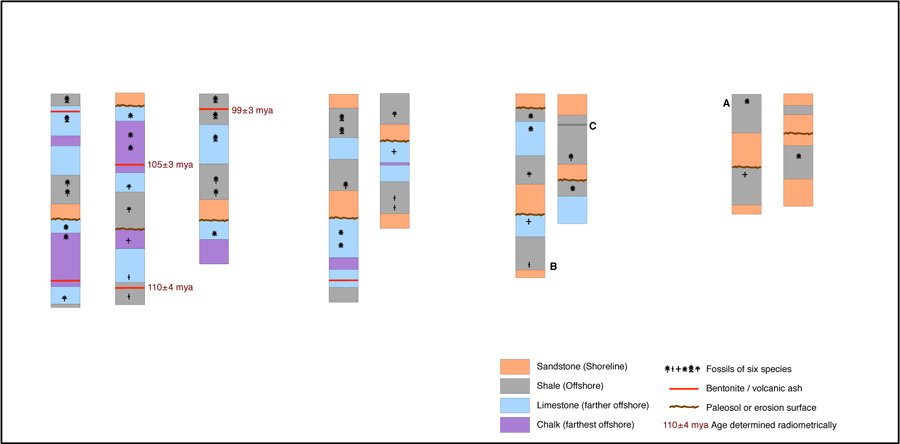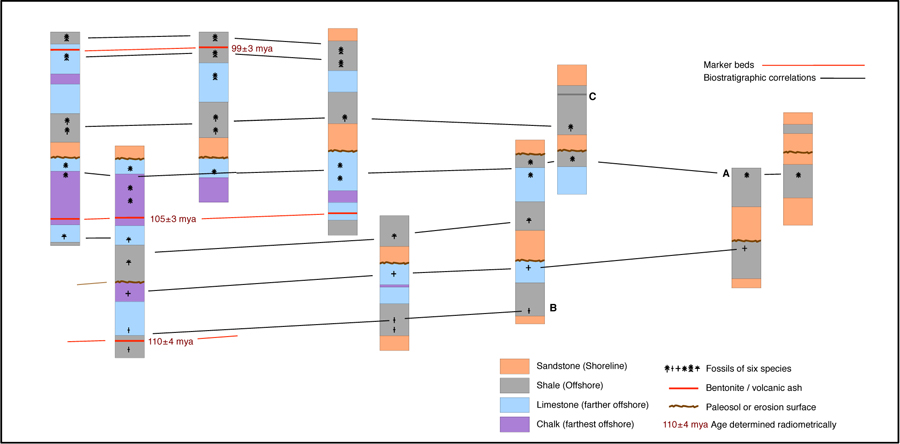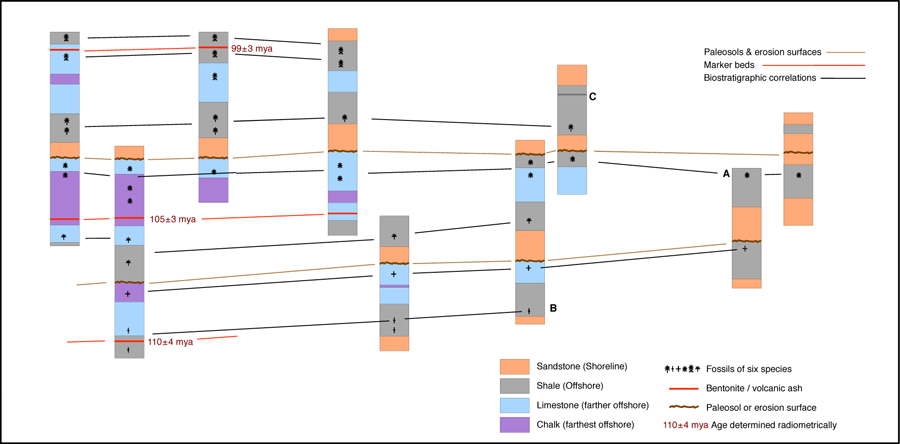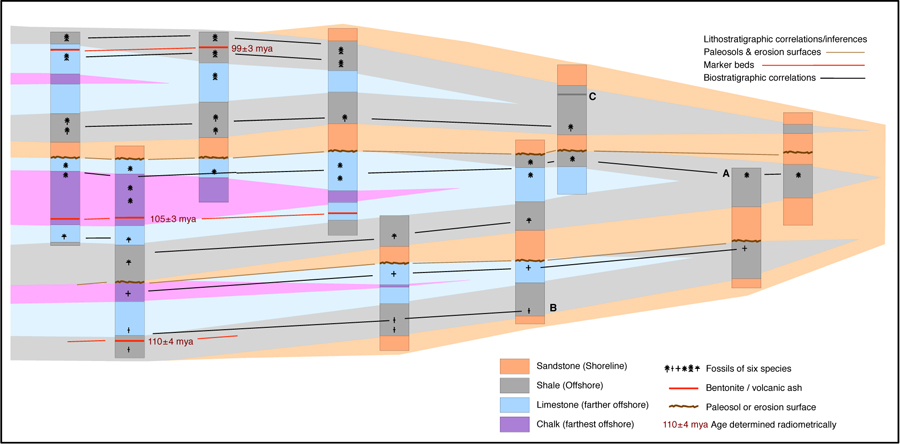|
Step 6
Which way (to the left or right) was landward, and which way was seaward? Landward was to the right (the direction of the sands, derived from land) and seaward was to the left (the direction of the chalk, deposited in deepest water).
How many cycles of rising and falling sea level are evident from your cross-section? There are three, evident two ways: (1) the three vertical sequences with chalk in the middle, because chalk represents the deepest-water enviroment and thus the highest sea level, and (2) the three cycles of facies shifting to the right (landward) and then back to the left.
During which geologic period were the sediments in this cross-section deposited? The Cretaceous. Comparison of the radiometric ages with the geologic time scale requires that the period be the Cretaceous. More generally, Earth's lack of chalks in older strata and the abundance of chalk in Cretaceous strata also make a Cretaceous age for this example a likely inference, even if we had no radiometric ages.
How old is the fossil labeled "A"? It appears to be about 103 or 104 m.y. old, as suggested by the biostratigraphic correlations leftward from A to the region where there are radiometric ages.
How old is the fossil labeled "B"? It appears to be about 110 m.y. old, as suggested by the biostratigraphic correlations leftward from B to the region where there are radiometric ages.
How old is the layer of rock labeled "C"? It appears to be about 100 m.y. old, as suggested by the biostratigraphic correlations leftward from C to the region where there are radiometric ages.
Note that there are no radiometric ages for A, B, and C, but we can estimate their ages thanks to biostratigraphic correlation.
Comparing the strata above the three chalks, why is there limestone and shale above the chalk in the uppermost cycle, just limestone above the chalk in the middle cycle, and neither limestone nor shale above chalk in the lowermost cycle? Erosion cut down more extensively during the lowstand of sea level between the first and second cycles, not quite as far down during the lowstand of sea level between the second and third cycles, and still less far down during the lowstand of sea level after the third cycle.
Why is no fossil species found both below and above an unconformity or sequence boundary? Each of the sequence boundaries (the collective paleosols and erosion surfaces) represent time that is not represented by rocks and fossils in this section: during that time, there was deposition of sediment subsequently eroded, or there was erosion. These missing time intervals may be sufficiently long to make survival of a species across that time interval unlikely.
Final comments:
Note that none of the time lines that we drew in Steps 1, 2, and 3 cross each other. By definition, they shouldn't, because crossing of two lines that each synchronous events would mean a reversal of older-younger relationships, or a temporal paradox.
Final caveats:
The facies model used here, of sandstone-shale-limestone-chalk from land to deep sea, is not necessarily the case everywhere - it's just a simple model to make a simple exercise.
Paleosols are commonly not present and erosion surfaces are commonly not obvious. In many cases, unconformities have to be inferred not from obvious evidence like paleosols and erosional scouring but only from the position of unlikely sedimentary rocks over others. An example would be the sandstone-over-chalk or sandstone-over-limestone relationships at the left side of our cross-section, which raise the question "How were nearshore sediments deposited on top of far-offshore sediments?" The answer would be that the nearshore sediments weren't deposited on top of far-offshore sediments immediately after the deposition of the far-offshore sediments. Instead, a lot of time passed in which sea level fell and in which sediments overlying the far-offshore sediments were eroded.
Please keep the context of this exercise in mind. For introductory students, it will commonly be a challenging exercise that will hopefully expand such students' thinking about the geologic record. For advanced students a year or two further along in their education, it will be a strikingly easy exercise with many over-simplifications. It should be used by, or assigned to, introductory students, but it should not be assigned to, or used as a guide for interpretation by, advanced students for whom its simplifications can become pitfalls.
e-mail to Bruce Railsback (rlsbk@gly.uga.edu)
Railsback's main web page
UGA Geology Department web page
The content and opinions expressed on this Web page do not necessarily reflect the views of nor are they endorsed by the University of Georgia or the University System of Georgia.
| 




